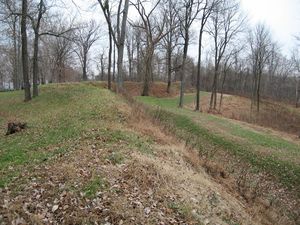Fort Duffield
| More information at Warlike, Wikipedia
Fort Duffield (1861-1862) - Construction began 3 Nov 1861 and was completed about 1 Jan 1862 by the 9th Michigan Infantry and the 37th Indiana Infantry during the U.S. Civil War. The fort was named by Colonel William W. Duffield, Commander, 9th Michigan Infantry for his father, Reverend George Duffield. The fort was abandoned late in 1862 after the front moved further south.
Fort Duffield HistoryFort Duffield was built on a Hill overlooking the town of West Point, Kentucky. The fort was designed to protect the town of West Point which was the main supply depot for General William T. Sherman's command. There were up to 1000 troops stationed there. Fort Duffield was ideally situated on top of Pearman Hill so as to be virtually impregnable. The fort faced south and overlooked the town of West Point on north side. There were two large timbered gates at the east and west ends of an enclosing serpentine wall earthworks that protected the east, west and southern sides. The ten angles of the fort allowed for devastating cannon and rifle fire in any direction and there was a one mile clearing completely around the fort that would completely expose any would-be attackers. The distance from the top of the wall to the bottom of the surrounding ditch was 17 feet and the top of the wall was 9 feet wide. A spring inside the fort provided continuous supply of fresh water. Current StatusPreserved with reproductions of several log cabin structures. Maintained by volunteers from the Friends of Fort Duffield.
Sources: Links: Visited: 16 Nov 2006 Fort Duffield Picture Gallery
| |||||||








